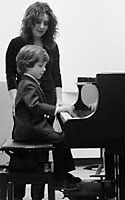Keeping the Music Student Motivated by Noémie L. Robidas
/ September 9, 2004
Version française...
 According to a study done in France in 1995, only one per
cent of violinists with approximately 10 years of training will eventually make
a career of it. Perhaps this statistic is not all that surprising, considering
the relatively few opportunities available in the professional sphere. But what
is more worrisome is that less than four per cent of this group will play the
violin as amateurs, while 95 per cent will never pick up the instrument again.
Other studies suggest that a small proportion of children who take up the violin
endure more than three of four years of lessons. According to a study done in France in 1995, only one per
cent of violinists with approximately 10 years of training will eventually make
a career of it. Perhaps this statistic is not all that surprising, considering
the relatively few opportunities available in the professional sphere. But what
is more worrisome is that less than four per cent of this group will play the
violin as amateurs, while 95 per cent will never pick up the instrument again.
Other studies suggest that a small proportion of children who take up the violin
endure more than three of four years of lessons.
Studies done in Great Britain show that a substantial
number of young music students quit within the first 18 months, and 40 per cent
of those who do continue abandon the endeavour at age 11 or 12 – the
transitional age where children move from elementary to secondary school. Among
certain US schools with state-run music programs, statistics, though a few years
older, reveal even worse trends: 70 per cent of stringed-instrument students
quit playing, with the violin taking the prize as least popular instrument as 75
per cent of its adherents give it up.
In Quebec, the problem is harder to grasp because there
are fewer subsidized music education programs in public schools. Most musical
instruction occurs in private schools, which receive no subsidies from
government sources, and from which it is difficult to amass statistical
information of this kind. However, despite the absence of hard numbers in this
province, the testimony of many of its experienced music educators suggests that
the data from the aforementioned studies could well apply here, too.
Training a
musician can be considered a costly, time-consuming, and rigourous activity. For
example, some of the best violinists will have accumulated more than 10,000
hours of personal practice time before reaching the age of 21, and it usually
takes more than 10 years of practice and preparation to be able to perform at an
international level. Faced with such high levels of drop-outs among music
students, then, such an investment may seem to some hard to justify. For this
reason, it is important for teachers, parents, and pupils to understand what
factors influence whether or not a student continues to play an instrument.
What conditions might lead students to remain interested
in music? First and foremost, a desire to play an instrument is a must, along
with a positive attitude to the repertoire, instructor, concert performance, and
independent practice. Students must equally have a positive image of their class
mates as well as the ability to assess the rate of their own progress. Along the
way, aspirants will have to develop an intrinsic sense of motivation in order to
persist. The key to this is setting short-, mid-, and long-term
goals.
Meanwhile, instructors must adapt to the varying ages and
levels of their students. Younger beginners will work better with teachers who
are warm and affable, while adolescents will be inspired by skill and
experience. In both cases, instructors must be, of course, competent, and should
take great interest in the pupil's progress throughout their relationship. The
goal is to enable the child to improve and become more autonomous. Ideally,
lessons should be one-on-one, complemented by courses given in groups. Teachers
must frequently organize concerts and diverse activities whose purpose is to
solidify, apply, and improve on what the student has learned. Students should be
encouraged to enter competitions and master classes, according to their level
and personality. Finally, teachers must actively participate in the grand
enterprise of the "musical enculturation" of the student by revealing and
exalting the various elements of the musical universe and the instrument in
question (ie, repertoire, interpretation, music history, etc.).
Music must be a positive and present element in the
child's life (music at home, family concerts, attending professional concerts,
etc.). Having opportunity to experience intensely positive emotional reactions
to music from an early age on is important. Strong parental support will foster
a child's tendency to persist in music, while the absence of parents'
constructive participation in the process will prevent the student from
attaining higher levels. Such participation will evidently depend on factors
such as the age and personality of the child, the requirements of the
instructor, and the amount of available time one has. The role of the parent is
to supply the necessary elements for practice (instrument, scores, music stand,
etc.), encourage the child to practice, take notes during lessons, and supervise
practice.
Practice should be done regularly and efficiently, paying
special attention to structure and conscious repetition, and should take place
in a positive and comfortable setting. As the child's age and level increases,
practice should increase in difficulty and intensity so as to remain
challenging. A higher level cannot be reached without spending thousands of
assiduous hours practicing over the course of several years.
[Translated by Eric Ginestier]
Version française... |
|


